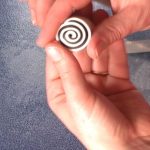Jelly Roll Cane – Perfect for Polymer Clay Beginners
Video #32: Making polymer clay canes is a fun skill that all beginners should learn early.
More...
IN THIS POST: — polymer clay canes — jelly roll cane — black clay — white clay — cutting blade — acrylic sheet — rolling clay — beginner polymer clay canes– reducing canes — simple polmer clay canes — millifiori — (Topics marked with an asterisk* are discussed in the Comments Section below).
You will probably spend as much time making canes, as you do with creating beads to apply your cane slices to. And the jelly roll cane design is a great place to start learning. They are very easy to make. Fun too.
This popular beginner cane is made by rolling together 2 flat sheets of polymer clay, using contrasting colors. I often combine black and white, but the choice is yours.
When selecting the clay for your cane, it’s best to choose the same brand for each color. Also be sure to condition each of the layers to the same degree. If one is softer or harder than the other, you may run into problems with the separate layers not “playing nice” together.
Don’t worry if your jelly roll ends up bigger than expected. Large diameter canes can be shrunk down to very small sizes by a process called cane reduction. But that discussion is going to have to wait for another day.
Transcript not available for this video.
Our goal is to translate these videos into as many languages as possible. If you are interested in helping with this initiative, then please do contact us and we will figure out a way to make it worth your while :)
Resource Links:
- Related Video: How To Slice Round Polymer Canes Without Distortion
- Related Video: Reducing a Polymer Clay Cane From Start To Finish
- Related Video: Polymer Clay Zinnia Flower Cane Mini Tutorial
- Related Video: Rose Brain Cane Tutorial (Intro)
- Related Video: Polymer Clay Cane Tools Supplied by Tiny Pandora
- Amazon: Polyform Sculpey Super Slicer **
Resources marked with a double ** asterisk are affiliate links. If you click on them and decide to buy something, we may receive some compensation. This does not affect the price you pay in any way. What it does do, however, is helps us to continue providing free videos for you, here at the PcT website. Using our links to purchase your tools and supplies, is always greatly appreciated.
Sponsored Ads & Special Promotions

Shareable Images

Want to chat about today’s post? That’s what the comment section below is for. Scroll Down… We’d love to hear from you!
Or... if you would like to request a topic for a future post, here is the link to do that… PcT Suggestion Box

Thank Deborah for sharing your thought feedback. I really appreciate it!
Hi, Cindy
I just finished going through your beginner’s course. I am new to polymer clay. I have purchased books before but could get just so far. The course was great. The videos were the right amount of time for me and your instruction was very clear. It’s nice to know that I can go back to review. I appreciated the tips/suggestions.
Great question Katina!
Size doesn’t really matter with jelly rolls. The longer the sheets are the more ‘turns’ in the spiral. The wider the sheets are the more rolls you can cut. So it is really a personal preference.
Cindy Lietz’s last blog post..Premo Clay Flower Pendant Necklace Project with Vintage Glass Beads
Does it matter what size of polymer clay you start with before you make the jelly roll? Is there a formula for amounts that will yield certain sizes and numbers of beads?
As The Polymer Clay Tutor, my goal is to help beginners avoid making frustrating mistakes that I know can be discouraging. If you have any questions, feel free to ask away in the comments section below. I’d be happy to getting you going in the right direction.
Cindy’s last blog post..Making Polymer Clay Beads all the Same Size